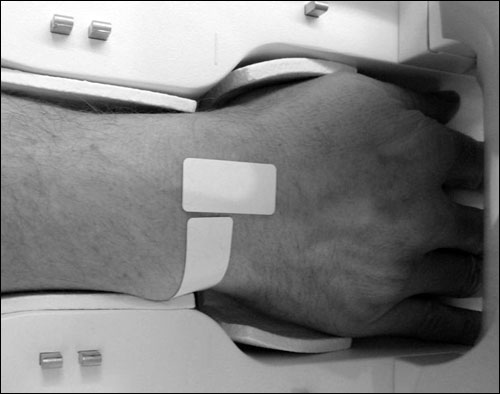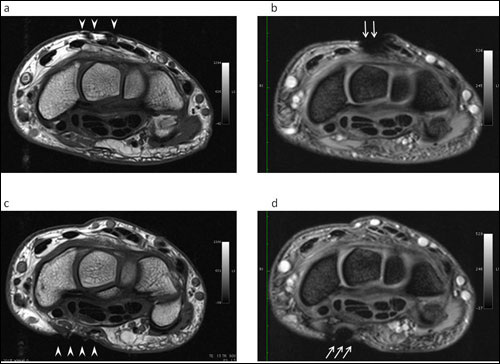Researchers at St. Gallen Canton Hospital, in Switzerland, have found that high-frequency (HF) 13.56 MHz RFID tags do not significantly interfere with the functionality of imaging devices, nor do those devices affect the tags’ functionality. The study, undertaken by physicians and researchers at the hospital and at the University of ETH Zurich, found that magnetic resonance imaging (MRI) radiation could raise the temperature of tissue around an RFID tag by, at most, 4 degrees Celsius (7 degrees Fahrenheit), but had no effect on a patient’s health.
The quality of the MRI images was minimally impaired by the RFID tag’s presence, the researchers report, and was limited to the area of the skin on which it was attached. Furthermore, the tag had no effect on a computed tomography (CT) scan’s image quality. The results were published last month by Patient Safety in Surgery, an online peer-reviewed medical journal.
The study’s results, according to the project’s lead researcher, surgeon Thomas Steffen, prove that RFID wristbands can safely remain on a patient as he or she undergoes diagnostic procedures, such as MRI and CT scans. Steffen first conceived of the study in early 2009, to address the lack of evidence regarding the functionality and potential for safety or health hazards with the use of RFID in combination with MRI or CT scans. The researchers did note, however, the existence of a prior study examining the effects of MR scans on low-frequency passive RFID tags implanted under the skin (see Magnetic Resonance Imaging & VeriChip RFID Human Implant at 1.5 Tesla).
The researchers chose to test tags that operate at 13.56 MHz because that is the RFID frequency most commonly used in patient wristbands. The study involved 60 HF 13.56 MHz tags made with NXP Semiconductors‘ ICode SLI chips, and compliant with the ISO 15693 and ISO 18000-3 standards, in two sizes—half of them with 76-by-45-millimeter (3-by-2-inch) etched aluminum antennas, the other half with 31-by-14 millimeter (1-by-0.6-inch) etched copper antennas. Christian Kern, RFID solutions provider InfoMedis‘ chief technology officer, was the study’s coauthor, and contributed the RFID tags and consultation regarding their usage.
In order to perform a reliability test with the RFID transponders, 15 of each of the two tag types were first read using Feig Electronic‘s Obid-MR100 interrogators, then 15 of each size were scanned by an MRI machine, and then by a CT machine, after which they were read once more. In groups of five, the RFID tags were attached to the sides of a 300-by-215-by-80-millimeter (9-by-8.5-by-4-inch) cardboard box, and were then scanned. A standardized scanning protocol was employed during MRI and CT scanning under the same conditions that would be present during a patient examination. The test was performed twice, for a total of 60 tag tests.
When testing tags mounted on cardboard boxes, the researchers utilized a CT scanner, as well as 1.5- and 3.0-tesla MRI scanners, employing the standard protocol for a cranial examination. The team also put some tags through “worst-case” sequences, in which they were subjected to MRI imaging for up to two hours. After being exposed to the magnetic fields of the MRI machines and the X-ray radiation of the CT machine—including the worst-case scenario—none of the tags showed any loss of function or alteration of the data (a unique ID number), Steffen says.
In the case of MRI scans, the researchers also tested the system on a live volunteer, and found that the RFID tags did have some effect on MRI images of the volunteer, who wore the tags taped to the wrist. For the MRI images, Steffen says, the tags left a minimal amount of artifacts (misrepresentations) by creating a shadowing effect on the MRI image, but it was minor enough not to affect the quality of these kinds of diagnostic tests. It could, for example, interfere with visibility of the skin directly underneath the tag, but the remainder of the wrist to which that tag was attached was still clearly visible. Therefore, the researchers recommended against placing an RFID tag directly on the region of interest in MRI examinations (a skin lesion or malignant melanoma, for instance).
Another phase of the testing studied temperature increases in tissue next to an RFID tag. This portion of the study was undertaken at the University of ETH Zurich, led by Roger Luechinger, a researcher at the university’s Institute for Biomedical Engineering. In this case, tags were attached to a container of saline solution and a gelling agent to mimic the human arm, with sensors installed to track any temperature changes in the solution. The tagged container was then subjected to MR radiation. The greatest increase was determined to be approximately 4 degrees Celsius (7 degrees Fahrenheit). This, the study’s authors determined, would be minimally perceptible to those wearing an RFID wristband. When a volunteer then wore the tags taped to his or her wrist, and placed his or her own arm in the MR scanner, the same results were found, he says.
“We conclude that patients wearing RFID wristbands are safe in 1.5-T and 3-T scanners using normal operation mode for RF field when the types of tags tested here are used,” the researchers wrote, referring specifically to the two InfoMedis tag models they had evaluated.
The study concludes that “wristbands for patient identification equipped with RFID transponders not containing ferromagnetic components do not have to be removed for MRI and CT scanning.” However, the researchers do add the following caution: “Although the types of RFID tags tested in our study are those most likely to be used in hospitals, we are aware of the fact that there is a huge market of different types of RFID tags. These other types of RFID tags need to be tested in different MR conditions and also under other clinical conditions.”
As a result of the testing, Steffen indicates, he is confident that RFID-based wristbands are a safe and reliable option for patients, even if they undergo MRI or CT scans. Now that the study has determined that the technology can operate safely in a hospital’s imagining environment, he says, the next step is for vendors or users to develop applications for RFID in Swiss hospitals. “It’s good to know that a wristband can be left on in an MRI machine,” he states, but few hospitals in Switzerland currently require wristbands to identify patients in hospitals (though they are commonly used in the United States, as well as in certain other countries). If Swiss regulations require ID wristbands in the future, he adds, hospitals may begin examining RFID technology as an alternative to bar-coding on wristbands to access patient data.
A copy of the study, entitled “Safety and Reliability of Radio Frequency Identification Devices in Magnetic Resonance Imaging and Computed Tomography,” is available online.



